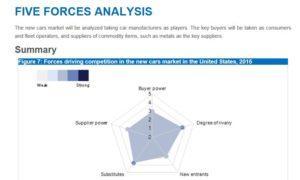//
You will use the EBSCO Library Database for this exercise.

Watch these Porter's Model Videos:
1. Michael Porter Interview
https://www.youtube.com/watch?v=mYF2_FBCvXw2. http://www.youtube.com/watch?v=DViVtgD0xwE Michael Porter "You Need a Strategy for your Organization"
Go to EBSCO and find the MarketLine Industry Report for "NEW CARS IN THE US". Read the entire report.

Now you are ready to Identify Porter's Five-Forces Model Table
- Create a table with the five forces on the left and snip and insert the 5 forces diagrams into the right side of the table table using the graphics in this report and your snipping tool on your computer under "Accessories".
- Now research your industry form you final project using the same process and find your industry's 5 forces.
- Create a table for your project. You r will tweet these slides at the end of the semester an part of your oral presentationl.
Watch this Generic Strategy Mini Lecture:
http://www.youtube.com/watch?v=V14kuqYEsxE&feature=share&list=ULV14kuqYEsxEWatch this video: http://www.youtube.com/watch?v=QPu4v_Ae0Vc&index=4&list=ULV14kuqYEsxE
4. Michael Porter Ties it all together at UNC Chapel Hill: "What is Strategy"
http://www.youtube.com/watch?v=KvYwKM5bY0s5. How to make America more competitive; Michael Porter is interviewed by Charlie Rose
Five forces
Threat of new entrants
Profitable markets that yield high returns will attract new firms. This results in many new entrants, which eventually will decrease profitability for all firms in the industry. Unless the entry of new firms can be blocked by incumbents (which in business refers to the largest company in a certain industry, for instance, in telecommunications, the traditional phone company, typically called the "incumbent operator"), the abnormal profit rate will trend towards zero ( perfect competition).
The following factors can have an effect on how much of a threat new entrants may pose:
- The existence of barriers to entry (patents, rights, etc.). The most attractive segment is one in which entry barriers are high and exit barriers are low. Few new firms can enter and non-performing firms can exit easily.
- Government policy
- Capital requirements
- Absolute cost
- Cost disadvantages independent of size
- Economies of scale
- Economies of product differences
- Product differentiation
- Brand equity
- Switching costs or sunk costs
- Expected retaliation
- Access to distribution
- Customer loyalty to established brands
- Industry profitability (the more profitable the industry the more attractive it will be to new competitors)
Threat of substitute products or services
The existence of products outside of the realm of the common product boundaries increases the propensity of customers to switch to alternatives. For example, tap water might be considered a substitute for Coke, whereas Pepsi is a competitor's similar product. Increased marketing for drinking tap water might "shrink the pie" for both Coke and Pepsi, whereas increased Pepsi advertising would likely "grow the pie" (increase consumption of all soft drinks), albeit while giving Pepsi a larger slice at Coke's expense. Another example is the substitute of traditional phone with a smart phone.
Potential factors:
- Buyer propensity to substitute
- Relative price performance of substitute
- Buyer switching costs
- Perceived level of product differentiation
- Number of substitute products available in the market
- Ease of substitution
- Substandard product
- Quality depreciation
Bargaining power of customers (buyers)
The bargaining power of customers is also described as the market of outputs: the ability of customers to put the firm under pressure, which also affects the customer's sensitivity to price changes. Firms can take measures to reduce buyer power, such as implementing a loyalty program. The buyer power is high if the buyer has many alternatives.
Potential factors:
- Buyer concentration to firm concentration ratio
- Degree of dependency upon existing channels of distribution
- Bargaining leverage, particularly in industries with high fixed costs
- Buyer switching costs relative to firm switching costs
- Buyer information availability
- Force down prices
- Availability of existing substitute products
- Buyer price sensitivity
- Differential advantage (uniqueness) of industry products
- RFM (customer value) Analysis
- The total amount of trading
Bargaining power of suppliers
The bargaining power of suppliers is also described as the market of inputs. Suppliers of raw materials, components, labor, and services (such as expertise) to the firm can be a source of power over the firm when there are few substitutes. If you are making biscuits and there is only one person who sells flour, you have no alternative but to buy it from them. Suppliers may refuse to work with the firm or charge excessively high prices for unique resources.
Potential factors:
- Supplier switching costs relative to firm switching costs
- Degree of differentiation of inputs
- Impact of inputs on cost or differentiation
- Presence of substitute inputs
- Strength of distribution channel
- Supplier concentration to firm concentration ratio
- Employee solidarity (e.g. labor unions)
- Supplier competition: the ability to forward vertically integrate and cut out the buyer.
Intensity of competitive rivalry
For most industries the intensity of competitive rivalry is the major determinant of the competitiveness of the industry.
Potential factors:
try { _402_Show(); } catch(e) {}
